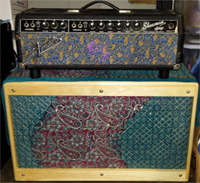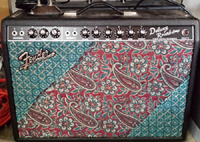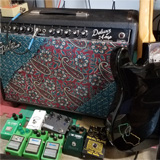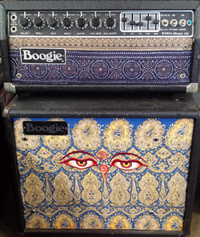
| Acoustic Guitars | |
| Electric Guitars | |
| » | Ampifiers |
| Outboard Effects | |
| Stomp Boxes | |
| The Dearly Departed |
About John: Equipment: Ampifiers
Amps
A Word About Mods / Repair
I got my first blackface Fender amp in 1993 -- a '66 Showman, purchased from Moonlight Music in Encinitas, CA -- and have been in love with that tone ever since. Unfortunately, like any old gear, these amps do need some attention to stay at the top of their game. Even more unfortunately, a lot of techs don't have a proper appreciation for the nuances of what made them sound good in the first place and can really take the life out of them. At one point I had a tech do a full "cap job" on my Showman, taking all the original blue molded caps out and replacing them with orange drops, which completely robbed it of its cream and sparkle, and its punch and response (that was about the time I bought and started using the Boogie a lot more). Years later Chris Haugen (formerly of San Diego based jam band Jambay, whose silverface Twin tone is one of the things that sent me down the vintage Fender path in the first place) introduced to Mike Pascale (http://www.VintageFenderAmpRepair.com) who is a genius and savant with these amps, and has done work for Bob Weir, Chris Robinson, Steve Kimock, Tim Bluhm, Jackie Greene, and many more. He's also started his own line of amps called Fat Jimmy Amps which I've yet to try but assume are every bit as good as a vintage Fender, but with the needs of modern touring players taken into account. In any event, Mike breathed new life into my Showman and I've been using him ever since -- he's been very generous with his time and knowledge, and I've come to rely on him a lot in my approach to amp purchases and maintenance. If you have, or ever get bitten by, the vintage Fender bug, make sure you have an excellent tech that you trust to keep it in its optimal operating condition.
1966 Fender Showman
Over the years, this has been my primary gigging amp for any room of any real size. It has a ton of volume out of its (very) conservatively rated 4x6L6 85 watts, and a deep rich tremolo that I haven't heard matched in any pedal or outboard unit.  One of my favorite local San Diego guitar players (Chris Haugen - Jambay) was playing a silver face Twin and I loved his tone so I jumped when I found a great deal on the Showman, despite not knowing much about it. Wonderful wide open clean tones with sparkly tops, and handles dirty sounds from pedals with grace and style (so much clean headroom, it's almost impossible to break up without pedals). It's essetially a Twin with no reverb, so for reverb I traditionally added an Alesis Microverb. More recently I've switched to the Catalinbread Topanga pedal, for its more distinctively authentic Fender spring reverb sound. I've also got a Peavy Valverb true tube reverb unit that I use from time to time. Generally with my non-reverb amps, I jump the reverb out of the vibrato channel and back into the normal channel, using the normal channel as the "return" to dial in the amount. The '67 / '68 Garcia tone is largely a combination of a Twin and a Showman (ok, with no shortage of the magic of the Wolf, and the man himself of course!). When Mike Pascale first got his hands on it, he did some basic repair (swapping out rickety tube sockets, etc.) and blueprint the vibrato channel back to blue molded caps and other NOS components. Then we talked mods/upgrades, and I had him convert the ground switch (no longer needed with a properly grounded power supply) to drop out 2 of the power tubes to half the output, slow down the tremolo to a sultry wide swing, convert the "Normal" channel preamp to a tweed style voicing (and enable the tremolo), and convert the "bright" switch to a "fat" boost. An already amazing amp restored and reimagined into an incredibly versatile tone monster. What's not to love?!
One of my favorite local San Diego guitar players (Chris Haugen - Jambay) was playing a silver face Twin and I loved his tone so I jumped when I found a great deal on the Showman, despite not knowing much about it. Wonderful wide open clean tones with sparkly tops, and handles dirty sounds from pedals with grace and style (so much clean headroom, it's almost impossible to break up without pedals). It's essetially a Twin with no reverb, so for reverb I traditionally added an Alesis Microverb. More recently I've switched to the Catalinbread Topanga pedal, for its more distinctively authentic Fender spring reverb sound. I've also got a Peavy Valverb true tube reverb unit that I use from time to time. Generally with my non-reverb amps, I jump the reverb out of the vibrato channel and back into the normal channel, using the normal channel as the "return" to dial in the amount. The '67 / '68 Garcia tone is largely a combination of a Twin and a Showman (ok, with no shortage of the magic of the Wolf, and the man himself of course!). When Mike Pascale first got his hands on it, he did some basic repair (swapping out rickety tube sockets, etc.) and blueprint the vibrato channel back to blue molded caps and other NOS components. Then we talked mods/upgrades, and I had him convert the ground switch (no longer needed with a properly grounded power supply) to drop out 2 of the power tubes to half the output, slow down the tremolo to a sultry wide swing, convert the "Normal" channel preamp to a tweed style voicing (and enable the tremolo), and convert the "bright" switch to a "fat" boost. An already amazing amp restored and reimagined into an incredibly versatile tone monster. What's not to love?!
1965 Fender Deluxe
 Looking for a lower powered amp than the Showman, I initially bought a "Deluxe Reverb '65 Re-issue" model to have a low volume alternative that I could play at home and in small rooms. I initially replaced the stock ceramic Jensen (the new production Italian one -- they don't sound great...) with a Weber alnico speaker. While in a way it's a nice pairing for the inherently chimey and lush tone of the amp, it's a little too soft and mushy for my taste so I ended up putting a Fat Jimmy C1250 in it and I'm now a convert -- this is the best speaker I've ever heard, and I'll never go back. Like (almost) all my amps I icovered the existing grill cloth with vintage Sari cloth (Reissue pictured right, '65 non-reverb pictured below, gap between chassis and cab not visible...). I fell in love with the overall vibe of amp, and the sweet power tube breakup tones that are impossible with a high power beast like the Showman. Playing it for years really made me want to look for an original (before something on the modern PCB designed circuit died in an urepairable blaze of glory...). That's when I found a screaming deal on a bit of a strange one -- a pre-CBS '65 Deluxe (non-reverb) chassis that was in all original condition, but had been removed from the original combo cabinet and put into a home made standalone head cab and the owner didn't really know what to do with it.
Looking for a lower powered amp than the Showman, I initially bought a "Deluxe Reverb '65 Re-issue" model to have a low volume alternative that I could play at home and in small rooms. I initially replaced the stock ceramic Jensen (the new production Italian one -- they don't sound great...) with a Weber alnico speaker. While in a way it's a nice pairing for the inherently chimey and lush tone of the amp, it's a little too soft and mushy for my taste so I ended up putting a Fat Jimmy C1250 in it and I'm now a convert -- this is the best speaker I've ever heard, and I'll never go back. Like (almost) all my amps I icovered the existing grill cloth with vintage Sari cloth (Reissue pictured right, '65 non-reverb pictured below, gap between chassis and cab not visible...). I fell in love with the overall vibe of amp, and the sweet power tube breakup tones that are impossible with a high power beast like the Showman. Playing it for years really made me want to look for an original (before something on the modern PCB designed circuit died in an urepairable blaze of glory...). That's when I found a screaming deal on a bit of a strange one -- a pre-CBS '65 Deluxe (non-reverb) chassis that was in all original condition, but had been removed from the original combo cabinet and put into a home made standalone head cab and the owner didn't really know what to do with it.  Since I'm always looking for good deals on non-collector condition but nonetheless great sounding / playing gear, it was a perfect match! Sooooooo, I picked it up and (even though it's a slightly narrower form factor than the reverb model) slotted it into the Re-Issue cabinet. As always, I sent it to Mike Pascale to do his magic -- blueprint channel 2, tweed voice channel 1, and slow down the tremolo. When needed, I can add reverb from any number of pedals (current favorite being the Strymon Flint, Catalinbread Topanga is pictured). Dreamy. [On a related note, does anyone need a '65 Reissue chassis with no cabinet? I've got one for sale...make me an offer -- it's a great sounding amp!] This thing is a fantastic on-the-go rig. It breaks up around 4 or 5, and with a clean boost like my Chase Tone Secret Preamp hitting the front end for a little bit of extra gain and drive on the input this thing is a dream. As added bonuses, I can play it at home without doing irreparable harm to my family's ears (or anyone else's on the block!), and I can carry it without throwing out my back. For a bigger gig, I sometimes A/B it with the Showman, using the Showman for clean tones and the Deluxe turned up for a saturated drive sound.
Since I'm always looking for good deals on non-collector condition but nonetheless great sounding / playing gear, it was a perfect match! Sooooooo, I picked it up and (even though it's a slightly narrower form factor than the reverb model) slotted it into the Re-Issue cabinet. As always, I sent it to Mike Pascale to do his magic -- blueprint channel 2, tweed voice channel 1, and slow down the tremolo. When needed, I can add reverb from any number of pedals (current favorite being the Strymon Flint, Catalinbread Topanga is pictured). Dreamy. [On a related note, does anyone need a '65 Reissue chassis with no cabinet? I've got one for sale...make me an offer -- it's a great sounding amp!] This thing is a fantastic on-the-go rig. It breaks up around 4 or 5, and with a clean boost like my Chase Tone Secret Preamp hitting the front end for a little bit of extra gain and drive on the input this thing is a dream. As added bonuses, I can play it at home without doing irreparable harm to my family's ears (or anyone else's on the block!), and I can carry it without throwing out my back. For a bigger gig, I sometimes A/B it with the Showman, using the Showman for clean tones and the Deluxe turned up for a saturated drive sound.
1967 Fender Vibrolux Reverb
When I bought this one, it needed a bit of work, including getting the Rverb circuit back in gear, so off it went to Mike Pascale for a little love and the standard set of mods. The reverb tank was actually dead, so I pulled the tank from my '65 Deluxe Reverb Reissue (see above -- replaced it with a vintage non-reverb amp, so wasn't using the tank anymore), and slotted it in, and bingo! Like all my amps, I covered over the grill cloth with some beautiful vintage Indian sari cloth for a unique impression. At 35 watts it's a bit of a middle ground between the Deluxe and the Showman, with more clean headroom but an ability to break up with some heat on the input, and the 2x10" speaker configuration, it's got a really tight and punchy response. It works great for recording and playing live in smallish rooms. Given the louder cleans, I typically get dirt out of pledals like my Tube Screamers, Klone, and FullDrive. It's loaded with a pair of 1971 Oxfords, reconed by Dusty's Speaker Repair, and the cabinet is inn near mint condition. Spectacular amp, classic blackface vibe and tone, gorgeous reverb and tremolo, nice tight response and punch. . John Hiatt wasn't kidding about the Tele / Vibrolux turned up to 10 combo...!
1985 Mesa Boogie Mark III
 A VERY early MKIII ("Black Stripe", serial number 103) introduced in 1985 following the classic MKIIC+ model, still using the massive IIC+ power tranny, among other things from it's predecessor's classic and highly coveted design. Perhaps not surprising that an amp that was originally modeled off of the Blackface Fender architecture but with lots of modern bells and whistles (especially the stacked gain stages) might be interesting to me... I happened to come across it right around the time my Showman was handicapped by a particularly mediocre tech, and with its punch and responsiveness I took to it really quickly. A MONSTER with all kinds of flexibility, in an incredible compact (but extremely heavy) head. This one really blows your hair back. Like many other Boogie players, I never quite figured out how to dial it in for real three channel usage (the settings you need to sound good on one channel are challenging to make work when you switch...), so when using it live I tend to use it for the clean and "Rhythm 2" channels for a more Garcia / Anastasio* sound rather than the lead channel Santana sound, and instead I get the dirt from whatever pedal du-jour I'm feeling in the mood for. I used this amp quite a bit when touring with King Harvest. I like it for recording because of the huge range of sounds you can get out of it (without having to be beholden to its limitations in the channel switching context), although given the volume it really needs to be stuffed in a closet... If only it had a tremolo circuit... (This is the only amp I own that doesn't have a tremolo -- I must admit that I'm completely and utterly obsessed with that sound!)
A VERY early MKIII ("Black Stripe", serial number 103) introduced in 1985 following the classic MKIIC+ model, still using the massive IIC+ power tranny, among other things from it's predecessor's classic and highly coveted design. Perhaps not surprising that an amp that was originally modeled off of the Blackface Fender architecture but with lots of modern bells and whistles (especially the stacked gain stages) might be interesting to me... I happened to come across it right around the time my Showman was handicapped by a particularly mediocre tech, and with its punch and responsiveness I took to it really quickly. A MONSTER with all kinds of flexibility, in an incredible compact (but extremely heavy) head. This one really blows your hair back. Like many other Boogie players, I never quite figured out how to dial it in for real three channel usage (the settings you need to sound good on one channel are challenging to make work when you switch...), so when using it live I tend to use it for the clean and "Rhythm 2" channels for a more Garcia / Anastasio* sound rather than the lead channel Santana sound, and instead I get the dirt from whatever pedal du-jour I'm feeling in the mood for. I used this amp quite a bit when touring with King Harvest. I like it for recording because of the huge range of sounds you can get out of it (without having to be beholden to its limitations in the channel switching context), although given the volume it really needs to be stuffed in a closet... If only it had a tremolo circuit... (This is the only amp I own that doesn't have a tremolo -- I must admit that I'm completely and utterly obsessed with that sound!)
* Trey Anastasio of Phish famously said of the Mk III Boogie he toured with for decades that despite being a "much maligned" amp (because of its infamous challenges with dialing in settings that work for switching between the three channels live), "being familiar with your gear is more important than having really good gear." Point taken (and he was able to achieve what many others failed at -- one of his secrets is use of the EQ in Auto setting, so it only applies to the Lead channel, giving an extra bility to control / tame that channel when you switch over), but I tend to consider this amp "really good gear" anyway...
1964 Fender Bandmaster
Another in my Blackface Fender collection (I believe the cutover from Blonde / tuxedo style was at some point in 1964, but this one is the later Blackface style). The Bandmaster is a head in the same chassis footprint as the Showman, but with 2x6L6 power tube output section (not unlike the mod I made to the Showman), and a solid state rectifier (unlike the Showman, DR, and VR, which are tube). So as compared to the Showman in 2x6L6 mode, the Bandmaster has a very tight response with less sag than a tube-rectified Blackface amp, and all that sparkly clean twang and spank. Nice clear articulation, with enough volume to stay clean at club volume, this is a great gigging amp paired with a 2x12.
1974 Fender Champ
The smallest in my Fender collection, this little Silverface is a beauty and sounds great at bedroom levels -- this is one you can actuall crank to 10 and get a nasty snarl and drive out of, without your neighbors calling the cops. Great practice amp, and I even played a house party show with it recently, and it did fine in that rock band setting even with a drummer (admittedly, a quiet one). I found a vintage Jensen 8" speaker to go in it that sounds fantastic. This is the only one of my amps that I haven't covered the grill with Sari cloth....yet.
2007 Vox AC15cc 1x12 combo
A re-issue of this classic I bought for a practice amp. Probably not what the original was, but still a nice British flavor in a small amp. At only 15 watts and with a master volume to boot, you can get great, cranked and saturated tones out of it without actually moving a lot of air. There's a killer tremolo channel too! This is a great amp for working on stuff at home, and I've even used it in small rooms before. I replaced the stock wolfdale speaker with the stock Jensen from the re-issue Deluxe, which was a bit of an upgrade to my ears -- some British vibe in the amp voicing, mellowed out with the speaker swap.
Cabinets
Custom Pine 2x12
I had a custom vintage Fender style cabinet built by TRM Guitar Cabs. Unfinished, just tung oiled, with a convertible (open / closed) 3 piece back. Very versatile cab, sounds great, and is beautiful with all the hand built tongue and groove joints showing. I load this up with a rotating cast of speakers. Right now, Celestions Classic Lead 80's, which a pair of easily handle any of the amps I throw at them. Tomorrow, who knows . . . ?
Mesa Boogie 1x12
A match pair to my Mark III head, this little bad boy is loaded with a Mesa branded Celestion Black Shadow -- a tweaked Classic Lead 80 designed to handle more power. Closed back cab design makes this thing extremely responsive and throws a ton of volume. Nice tight low end, lots of touch and response, very directional. Combined with the Mesa head, this thing is a beast.